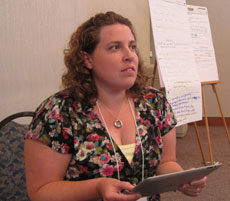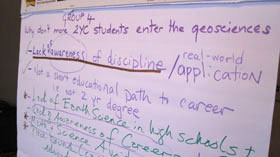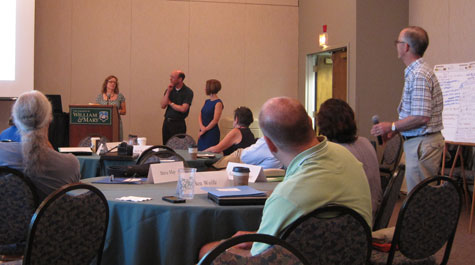SAGE 2YC: Excellence in earth sciences at two-year schools
Dozens of geoscience instructors across the nation gathered at William & Mary recently to discuss ways to enhance student success in earth-science programs at America’s two-year colleges.
The workshop, held July 17-20 on the William & Mary campus, was the latest offering of an collaborative initiative known as SAGE 2YC: Supporting and Advancing Geoscience Education in Two-Year Colleges. It’s funded by the National Science Foundation.
Heather Macdonald, Chancellor Professor of Geology, is a member of the SAGE Y2C leadership team, along with Eric Baer of Highline Community College, Bob Blodgett of Austin Community College, and Jan Hodder of the University of Oregon. Macdonald pointed out that science programs at America’s two-year colleges are important to reaching the widely shared goal of producing more graduates with STEM degrees. Many students at four-year institutions, including William & Mary, now begin their education at two-year schools.

“Our goal is to support good geoscience education at the undergraduate level,” Macdonald said. “Almost half of current undergraduates take science courses at two-year colleges.”
She added that many of America’s elementary school teachers get their science background from courses in programs at two-year colleges.
The William & Mary workshop theme was “Supporting Student Success in Geoscience at Two-year Colleges.” The event brought together geoscience faculty to compare notes and compare best practices for teaching student bodies that are often more diverse than the enrollment at four-year schools. Macdonald noted that instructors at two-year schools quite often teach classes that include students who are among the best and brightest with students who are the least prepared.
The class rolls in introductory geoscience courses include people who will become majors in geology, oceanography or other earth science subjects, as well as students who will never take another geoscience course. Macdonald noted that both groups are important.
“We want a geoscience-literate public,” she said, “and one way to achieve that is to have really high quality general-education and introductory courses.”
Faculty teaching geoscience in America’s two-year colleges have the same needs as their colleagues in four-year schools, but Macdonald notes geoscience instructors at two-year schools often lack access to the discipline-specific support, resources and contacts that are a natural part of being a member of an academic department in a university.
“Some two-year schools have a department of geology or a department of oceanography,” Macdonald said. “But many other schools have a department of physical sciences or sciences and applied health—a department that includes a variety of disciplines. Quite often these schools will have a single full-time geoscience faculty member as well as several part-time faculty.”
Lynsey LeMay is an example of the type of instructor that benefits from the content available through SAGE 2YC programming. LeMay is a geology instructor at Thomas Nelson Community College, teaching physical geology, historical geology and oceanography classes. She’s also a double alumna of William & Mary, a 2002 product of the Department of Geology who received an M.S. in 2007 from the university’s School of Marine Sciences at the Virginia Institute of Marine Science. She also serves as president of the National Association of Geoscience Teachers Geo2YC Division.
 Between sessions at the “Supporting Student Success” workshop, LeMay explained that, like many other two-year college instructors, she has to work to point out the relevance of earth sciences to students at Thomas Nelson. Once the students are enrolled in a class, she often has to deal with another concern.
Between sessions at the “Supporting Student Success” workshop, LeMay explained that, like many other two-year college instructors, she has to work to point out the relevance of earth sciences to students at Thomas Nelson. Once the students are enrolled in a class, she often has to deal with another concern.
“One of the issues that comes up a lot is ‘Oh, this is harder than I thought. You guys really use math!’ There is a misconception about the rigor that is required,” she said. “Geology is more than rocks!”
SAGE 2YC uses a combination of workshops and web-based resources; many of the workshop presentations are posted on their website.
Participants in SAGE 2YC workshops discuss topics ranging from how to get students interested in taking geoscience courses to practical suggestions for helping student learn how to learn. “Supporting Student Success,” the William & Mary workshop, featured a number of sessions that focused on classroom skills. Among the presenters were a number of William & Mary faculty, including Katherine Kulick of the Department of Modern Languages and Literatures and Cheryl Dickter, Josh Burk and Janice Zeman of the Department of Psychology.
 Skip to main content
Skip to main content

